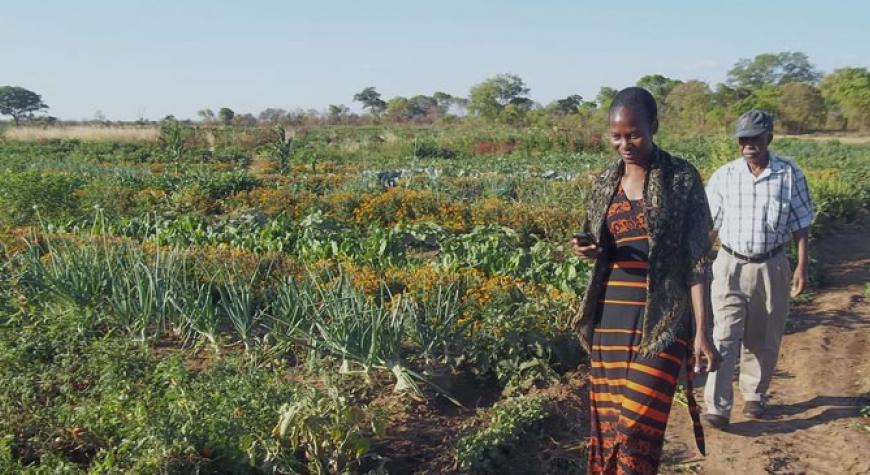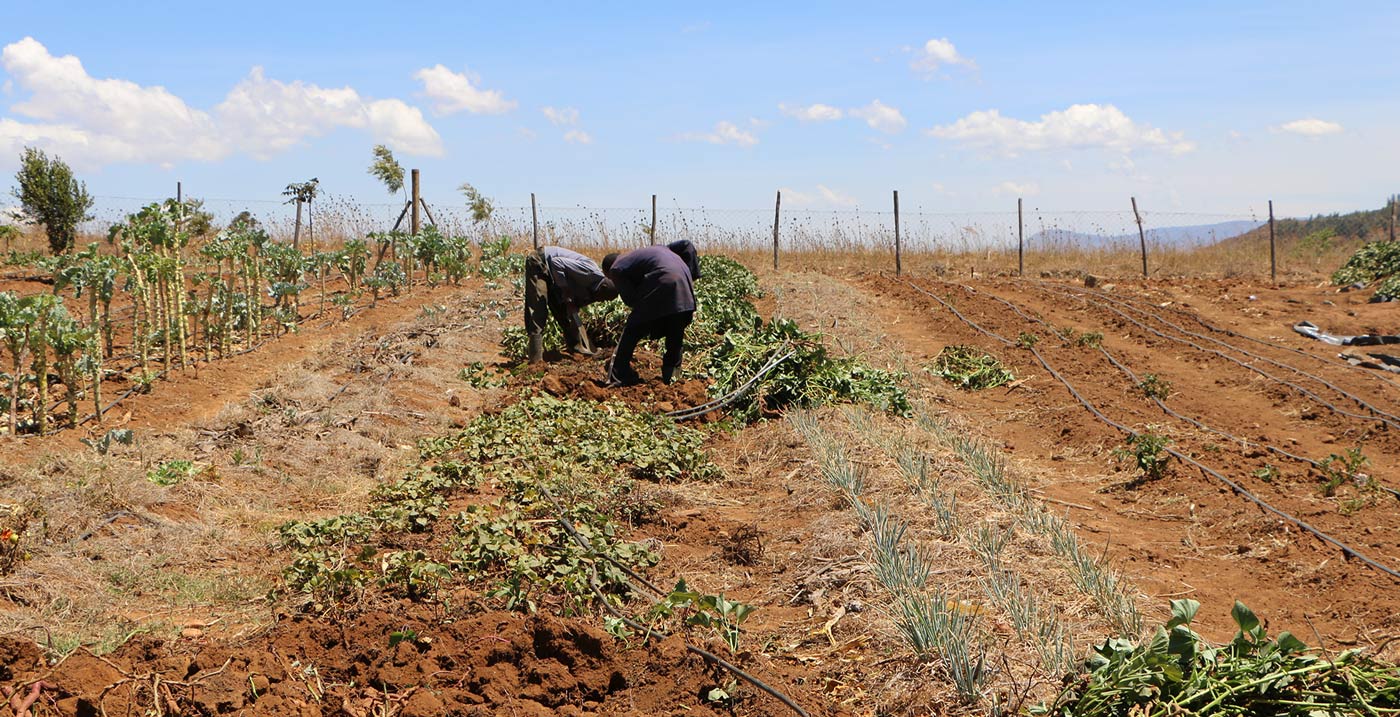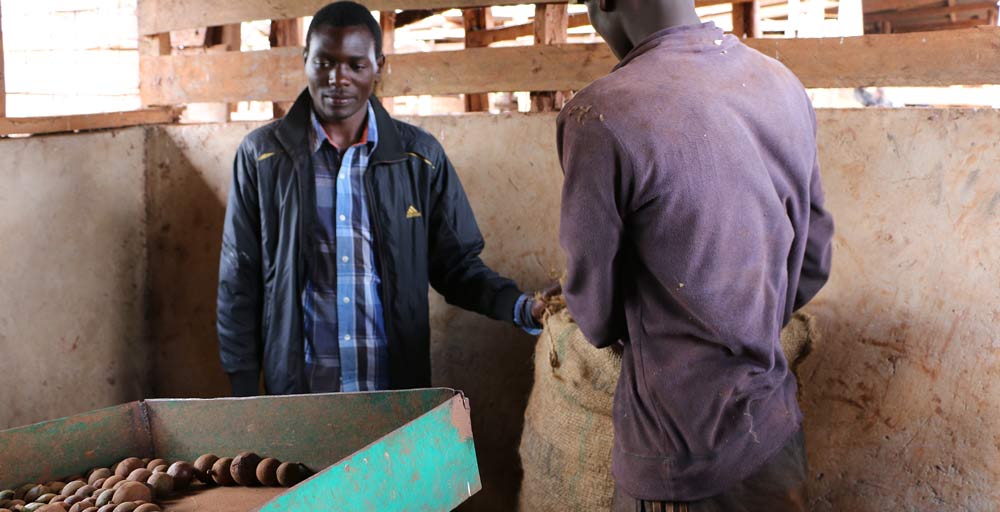


This post was first published on Organic Without Boundaries
We asked Kanayo F. Nwanze, former president of the International Fund for Agricultural Development (IFAD) from 2009 to 2017 and current FAO Special Goodwill Ambassador for Zero Hunger, Africa Region, some questions about food and farming.
Here is what he had to say:
Question 1 – How do you think we can break the vicious circle of poverty and hunger and ensure that feeding 9 billion people doesn’t put an extra burden on our ecosystems and biodiversity?
Feeding the world in 2050 has been described as the greatest challenge in human history. Actually, projections place the world population at 9.7 billion by 2050. That’s closer to 10 billion than to 9 billion, an additional one billion more mouths to feed than projected in 2015.
Yet it is, I believe, a challenge that we can meet, provided our efforts are inclusive and responsive to small-scale producers and farmers in developing countries. In fact, we already produce enough food to feed every child, every woman and every man on this planet. And paradoxically, one-third of world food production (1.3 billion tons per year) is lost or wasted. If one quarter of lost or wasted food were saved, it would be enough to feed the world’s hungry. And in Sub-Saharan Africa, a region that spends close to $40 billion annually to import food, grain worth up to US$4 billion a year is lost – enough to provide the minimum food requirements for at least 48 million people.
So we have to ask ourselves why are there almost 800 million hungry children, women and men on our planet? Why is it that over 6 million children under age five die every year, and 45 per cent of child deaths are due to malnutrition? In a world of plenty, why do so many suffer so much?
Fact is that hunger and poverty are pervasive in the developing world where the poorest and hungriest live in rural areas. Their source of livelihood is agriculture, smallholder agriculture. The world’s 500 million small farms produce around four-fifths of food supplies in developing countries. Yet today, too many of those who work to feed the world – at least in the developing world – are living on the breadline and going hungry themselves. This is a terrible and tragic paradox!
But how can we change this?
The answer is simple: invest in rural people, invest in smallholder producers, invest in rural development.
Experience has shown us again and again, in places as varied as Burkina Faso, China, Ghana, India, and Thailand, that smallholders can and do contribute to food security and can lead the way towards sustainable agriculture.
By investing in rural people and sustainable agriculture practices such as organic farming, we can achieve Zero Hunger, improve livelihoods and simultaneously protect the environmental health of our planet. Insofar as smallholder farmers are managers of agricultural landscapes, their choices have widespread impacts on the integrity of ecosystems. Since they are often located in marginal or degraded landscapes, involving them in adaptation solutions can make a crucial difference in restoring biological diversity, and in some cases bringing these areas under sustainable agricultural production.
Let me suggest the following considerations for achieving sustainable food systems:

Question 2 – Having identified the critical role smallholders play in sustainable agriculture, how do you think they can be empowered, in particular women farmers?
Let me start by saying that, globally, 85% of farms are less than 2 hectares and more than 2 billion people depend on 500 million small farms for their livelihoods. Smallholder farmers will play a key role in feeding 9.7 billion people by 2050, and rural women particularly in Sub-Saharan Africa and South Asia will be instrumental here.
To empower them means first acknowledging the obstacles they face and then taking action to overcome them.
Let us start with the lack of secure access to land and water. Without this there is no point in investing time, effort and capital to make land more productive. Also, a lack of access to markets and financial services is choking any entrepreneurial spirit farmers have. Smallholders need to transport their produce to where the consumer is with minimal waste and at affordable cost. We have to look at minimal collective organization meaning we need to have a stronger voice and be more efficient when packaging, processing, getting certification, marketing and negotiating fair prices. We have to invest in solutions for good infrastructure such as sanitation, clean water, power, schools and roads and bridge the information gap on markets and prices, techniques and technologies. For example, one of the most powerful tools in the hands of a rural small producer is the mobile phone. We need functional institutions, good governance, committed and visionary leadership and the rule of law to create enabling environments for investment and partnerships. We need to invest in establishing and strengthening the roots of sustainable and regenerative agricultural growth.
Given the role of women in successful food systems, empowerment of women, not just gender equality, opens doors for entire communities to strengthen their food and nutrition security and to improve their social and economic well-being. But to achieve gender equality, we need universal recognition of the human rights of rural women and we must pay greater attention to the vital role women play in the rural economy.
To enable women to participate in social, political and economic activities, we have to improve rural infrastructure and services.
We have talked about gender equality and women’s empowerment for so many years now.
But change does not just happen; it has to be made to happen.
Giving more support to women’s organizations would be a first step in the right direction.

Question 3 – Can you give us examples of countries that have made progress in the battle against hunger and where you see need for improvement? Which countries do you think could lead by example in fighting hunger and malnutrition in a sustainable way?
Hunger and malnutrition are not problems exclusive to low income countries in Africa and Asia. Middle Income Countries (MICs), despite some being global economic powerhouses, are home to the majority of the world’s hungry and malnourished. Brazil, China, India, Indonesia, and Mexico are among the world’s most populous countries while also ranked in the top 20 economies in terms of gross domestic product (GDP) (IFPRI, 2015). But unlike countries in Sub-Saharan Africa, they have each made remarkable progress in addressing hunger and undernutrition. For example, between 1990 and 2014 hunger was reduced in Brazil by almost two-thirds and in China and Indonesia by more than half and child stunting improved significantly in China from 1990 to 2013 and in Brazil from 1989 to 2007, declining by about two-thirds in both countries.
For the countries mentioned above, apart from an increased investment in agricultural research and extension services using their own financial resources, sound macro-economic policies, good fiscal management and investment in rural infrastructure went hand-in-hand with long-term agricultural development and investment plans. There were also inclusive social protection programmes such as conditional cash transfer in Brazil and Mexico, which targeted rural female-headed households as an additional incentive. These countries have also enjoyed significant periods of political stability except for one or two in recent months that fortunately, have not deteriorated into armed internal conflicts.
The picture in Sub-Saharan Africa (SSA) is not the same. Rwanda and Ethiopia are often cited as examples where progress is being made in the fight against poverty, hunger and malnutrition but undernutrition persists in both countries with 38% of children under five are stunted (IFPRI, 2015). The costs of hunger and undernutrition have also been estimated to reduce GDP by 10-16 percent in Rwanda, Ethiopia, and Malawi. More than one third of SSA countries are described as fragile and conflict-affected states with unstable governments, highly dependent on foreign assistance with a serious lack of coordination across sectors and actors within the food security and nutrition landscape. Added to this, SSA countries are plagued by blatant corruption, poor governance and disregard for the rule of law. Under these circumstances it is of little wonder that the region has made the least progress since 1990 in reducing the proportion of its poor, in fact it has increased in absolute terms.
The conclusion from the two scenarios presented above shows that the knowledge and innovation from the experience in reducing hunger and undernutrition in countries such as China, Brazil, Vietnam, and Thailand can be transferred to other regions of the world and particularly SSA through South-South cooperation and partnerships to achieve significant reductions in global poverty and hunger in response to the first two Sustainable Development Goals of Agenda 2030.

Question 4 – What are the most important fields for agricultural research in fighting hunger and malnutrition? How can we ensure the independence of science in the sector?
It would be presumptuous to attempt to define or prescribe the type of research that would bring about a dramatic reduction in global hunger and malnutrition. There are stark differences between regions of the world in the state of agri-food research or in the level of utilisation of existing technologies. Public spending on research and development (R&D) is lowest in the regions that need it most. High-income countries account for 57 per cent of spending, measured in purchasing power parity dollars, compared with only 11 per cent for low-income countries.
In 2015, Sub-Saharan Africa, which needs to transform its food and farming systems more than any other region in the world, spent only 5 per cent of their national budgets, roughly the same as Brazil. This is unfortunate, because without investment in research, we are unlikely to see the transformation of the rural space that is so desperately needed in developing countries to improve food security, nutrition, and economic growth. I argue that for most of Sub-Saharan Africa, change must begin from within. And this change would involve first and foremost a strong and committed political leadership, good governance, elimination of blatant corruption, transparency, the rule of law, accountability, fiscal discipline and time-tested macro-economic policies that put agriculture as the backbone to sustainable economic and social development and transformation.
But agricultural research must be focussed on development outcomes. We tend to focus on biological and physical experiences. In my years of working in development, I have learned that science has the greatest impact when it is combined with an understanding of the softer sciences. We must apply the same rigour of thought to understanding the social dimension of local communities who most need to benefit from our research work. Here let me also add that too little attention is given to policy research because with all the technology that can be pulled off any bookshelf, unless there are sound policies and well informed policy makers and institutions, we will make little or no progress.
Let me make one last comment on science, technology and innovation as they relate to agriculture and food systems. Innovation does not necessarily mean doing something “new”. It does not need to be a negation of the past. It may simply mean using a traditional technology and adapting it or using it in a new way. For a small farmer in the West African Sahel learning to compost can be as innovative and more effective than investing in advanced technologies that may not be suited to the realities of small-scale farming. This is a great example of valuable indigenous knowledge for which we need not pay royalties!
Question 5 – According to José Graziano da Silva, FAO Secretary General “Agriculture can help us tackle climate change, poverty, and food insecurity at the same time — agroecology can be a concrete option in addressing these challenges.” What contribution do you think agroecological approaches such as organic agriculture can make to reducing poverty and addressing hunger and malnutrition?
We need to have a clear understanding of and between “organic agriculture” and “agroecology”. The latter, agroecology, “is a scientific discipline, a set of practices and a social movement. As a science, it studies how different components of the agroecosystem interact. As a set of practices, it seeks sustainable farming systems that optimize and stabilize yields. As a social movement, it pursues multifunctional roles for agriculture, promotes social justice, nurtures identity and culture, and strengthens the economic viability of rural areas” (FAO). On the other hand, organic agriculture is strictly speaking, a practice and the definitions are still hotly debated but most agree that it involves using biological inputs instead of synthetic chemical inputs and basically involve such approaches as soil-conservation, crop rotation, and the use of green manure, local resources and traditional knowledge. Both terminologies are often used inter-changeably and in this respect, whether we speak of agroecology or organic agriculture, both are in tune with the Sustainable Development Goals (SDGs) and the basic principles of being environmentally, socially and economically sustainable.
One of the main features of Agroecology is that it looks for local solutions and linkages with the local economy and local markets, and gives farmers the opportunity to achieve improved livelihoods and a better quality of life. So, Agroecology could play a very important role in ending poverty and hunger. As a local solution, based on local needs, another advantage of Agroecology is that it also aims at the production of more nutritious and culturally appropriate food and produces less food waste. Production is also diversified, so farmers produce a variety of foods with different nutrients and this ensures a balanced diet.
The falling prices of conventional crops has jeopardised the economic feasibility of small farmers in developing countries. Organically-grown products, on the other hand, fetch a significantly higher price and offer a viable alternative. There has been a dramatic growth in global demand for organic produce especially in the European Union, United States and Japan, a demand that is growing more quickly than for other food products. However, in order to tap into these new markets, small producers must overcome a number of hurdles, such as lack of technical know-how, limited storage and processing facilities, inadequate market information, complex certification processes and insufficient financing. It is vital to have supportive government policies that foster development in these sectors, particularly in the case of the rural poor, who often lack access to the technological and financial resources needed to take advantage of these new opportunities.
Smallholder producers actually are well placed to adapt “scientific” agroecological approaches to food security and nutrition. Being the least responsible for greenhouse gas emissions and climate change, they are natural practitioners of low-input labour-intensive agriculture, have little or no negative impact on people or the environment, and generate little waste of whatever food reaches their homes. They already hold the tools for practicing Agroecology, increasing their own resilience, becoming more inclusively competitive, accessing global markets and becoming more economically empowered to support their families. Support by governments and their institutions would be critical in enabling them to become central players in the achievement of the Sustainable Development Goals.
Watch a video message from Kanayo F. Nwanze at the COP22 Climate Conference.
Add new comment